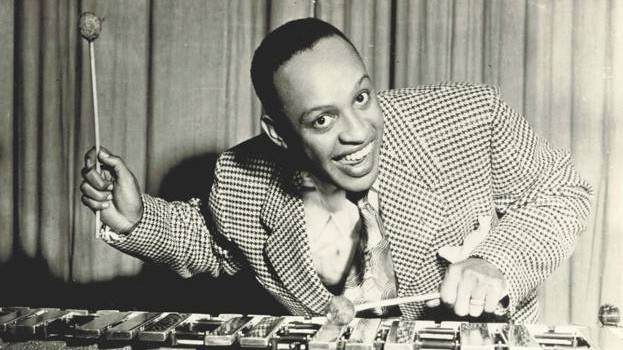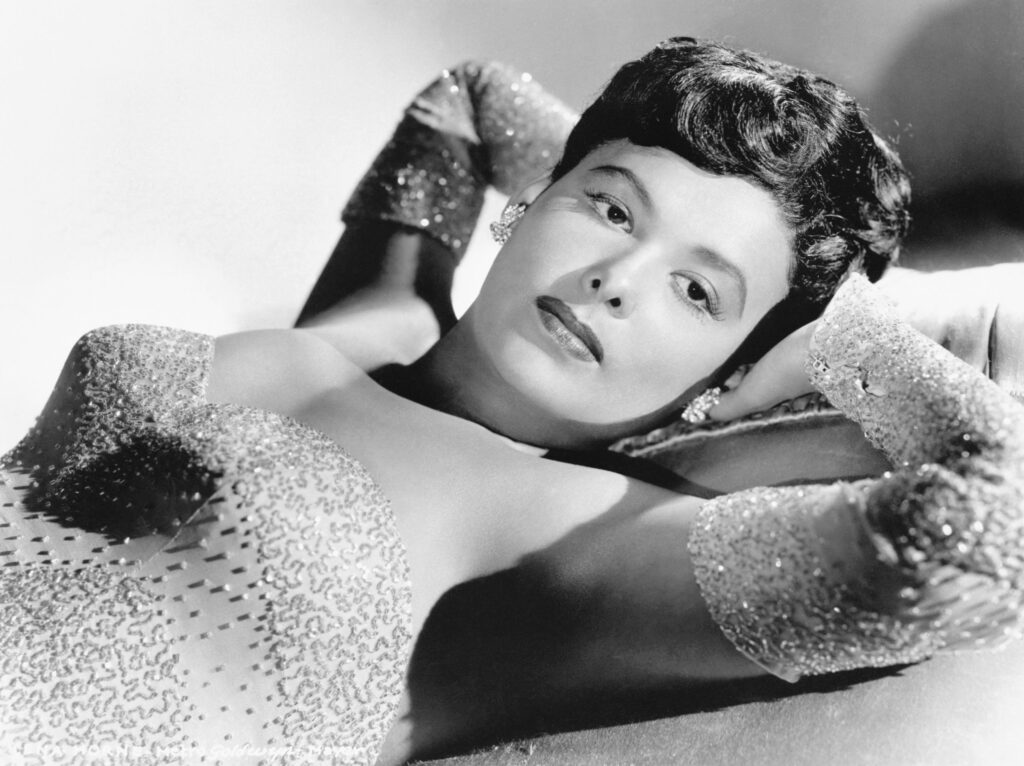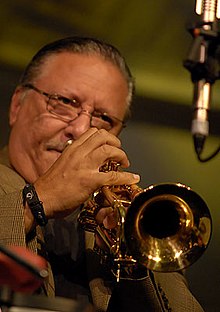Carmen McRae – April 2020 Artist of the Month
Written by Emily Morrow on April 1, 2020
If a Mt. Rushmore existed for Jazz vocalists , who would be enshrined there? Surely the likenesses of Ella Fitzgerald, Sarah Vaughan, and Anita O’Day. Many would also place our April Artist of the Month, Carmen McRae, there among the best and most influential singers that Jazz has ever encountered. Let’s consider why.
Carmen McRae embraced the Jazz scene well before she made her first records. Born on April 8, 1920, Carmen’s loving family eventually settled in Harlem’s Sugar Hill neighborhood. During high school, she studied classical piano and composed original tunes. She never had formal vocal training, likely learning and imitating pop tunes from radio listening and, according to her cousin, absorbing at least some vocal inflections from their West-Indian grandmother’s singing style.
Her first step towards greatness in the late 1930s may have started by Carmen’s attraction to and immersion in the vitality of Harlem’s abundant nightclubs. As an attractive 19-year-old, Carmen formed connections and friendships there, with many emerging or established Jazz stars. One of those friends, accomplished composer and pianist Irene Kitchings, introduced Carmen around local nightclubs to her ex-husband Teddy Wilson’s musician friends, one of whom was Billie Holiday. Kitchings encouraged Carmen’s songwriting talents, which produced an early composition, “Dream of Life,” which Holiday recorded in 1939.
By the 1940s, Jazz’s bebop style was in full bloom at Harlem’s famous Minton’s Playhouse nightclub, where musicians were allowed the freedom to break away from Swing-era playing styles and solo at length. Carmen made a place in this world as a charismatic and vibrant personality—making connections, and occasionally playing piano–not yet by singing, however. It was at Minton’s that she met a host of Jazz greats—Louis Armstrong, Dizzy Gillespie, Sarah Vaughan, Count Basie, Lester Young, Duke Ellington, Ben Webster, Monk, Art Tatum, and Kenny Clarke among them. As time went on, Carmen would record with many of these legends…and drummer and bebop forerunner Kenny Clarke would become the first of Carmen’s two husbands.
Carmen would become known as one of Jazz’s first vocalists to engage with bebop. Pianist and arranger Mary Lou Williams encouraged Carmen’s piano playing. Later Tony Scott, an influential bebop clarinetist and arranger, recognized her singing talents and encouraged the flexing of her vocal abilities. In 1944, Carmen made her first significant splash as a singer by appearing behind the mic with the Benny Carter Band. From there, she would sing with Count Basie, then work a short stint as a pianist with the big band led by Duke’s son Mercer Ellington, where she made her first recording in 1946 of a tune called “Pass Me By.”
The late 1940s through the 1950s is a period of Carmen’s career development, craft refinement, and character building. Her marriage to Kenny Clarke flickered out. She met and fell for comedian George Kirby, and shortly after, both decided to seek opportunities in Chicago. The couple soon split up, but Carmen stayed, booking piano and singing gigs at several clubs for nearly four years. Carmen later saw her Chicago years as the best musical schooling ever—a powerfully positive impact on developing her talent and her confidence. But she ultimately was disappointed in her failure to make substantive career moves. Growing envious of the prestige accumulated by friends such as Sarah Vaughan, she resolved to make changes, and so it was back to her Harlem stomping grounds in 1952.
In the Fifties, Carmen turned the corner. Back in New York, she struggled by working as much as possible; her 1953 recording “A Foggy Day” became her first hit tune. Finally receiving hard-won recognition, Carmen McRae’s popularity was on the rise. She recorded for two independent labels and then Decca, deals that produced 12 albums over five years. Those Decca years arguably produced her most prized recordings, featuring the distinctive Carmen McRae lyric-centered, behind-the-beat vocal style. Torchy and Boy Meets Girl with Sammy Davis Jr., released during this Decca period, are among the highlights.
By age 34, widespread recognition for Carmen’s music finally started rolling in. Down Beat magazine awarded her the “Most Promising New Vocalist” of the year. Polling at Metronome magazine put McRae in a tie with the great Ella Fitzgerald. Hollywood followed with a cameo singing appearance for the 1955 movie The Square Jungle, which starred Tony Curtis. Invitations to appear on television shows rolled in; TV hosts compared her talents with the those of the world’s best singers.
Steve Allen interview 1958:
In 1961, McRae’s second album with the Dave Brubeck Quartet, Take Five Live, sold a million copies, with her sung version of the title song becoming her biggest hit. As a leader, Carmen never had a million-selling album; her biggest single was 1956’s “Skyliner,” and even that sold less than a million records. Though nominated seven times, she never won a Grammy® award.
This 1961 interview on Ralph Gleason’s program Jazz Casual includes the classic ” ‘Round Midnight,” and three other songs, as well revealing insights into her personality and vocal style.
Carmen worked hard to maintain her place in a Jazz terrain that was changing—was it in fact ‘dying’? As with “Take Five” she proved with “Sounds of Silence,” “Send In the Clowns,” “Wave,” “You Are the Sunshine of My Life” and myriad other modern standards that she could surf the trends while remaining her own artistic self. In the Jazz resurgence of the late 1970s, Carmen capitalized by recording steadily and appearing in the top clubs and festivals worldwide. Over the next two decades, the Jazz public would reap the benefits of thorough coverage on multiple labels. Blue Note’s At the Great American Music Hall featured Dizzy Gillespie on several tracks. This one was Grammy® nominee, as was the live album, The Carmen McRae–Betty Carter Duets. Yet another, Carmen Sings Monk, honored compositions by her old friend.
Carmen was temperamental in personality and fierce in business. In the male-dominated music industry of this era, she had to be. She expected sidemen to know and adapt to her stylings; those who did not became unemployed. Onstage, Carmen could connect with her audience, but listeners would never know what mood to expect. Receptive audiences were rewarded with a topnotch effort, as in these segments from the Newport Jazz Festival (1988) and Tokyo (1986)
McRae’s last recording was a tribute album to her longtime friend, Sarah Vaughan. Sarah: Dedicated to You was released in 1991. Carmen McRae’s last performance occurred at New York’s Blue Note Club on May 21 of the same year. Retiring soon after, Carmen succumbed to the effects of a life-long smoking habit and passed away at home in California in 1994.
Many viewed Carmen McRae as a “Singer’s Singer.” Early in her career, she admitted to the influence of Billie Holiday’s voice and unique phrasing technique. Audiences could expect to hear a tune honoring Billie and her legacy during nearly every show. Hear for yourself the 1961 album Carmen McRae Sings Lover Man and Other Billie Holiday Classics, which was recorded shortly after Lady Day’s passing.
Carmen was a no-nonsense perfectionist. Over time, her voice matured and took on distinctive gritty and gutsy qualities. James Nodal in All About Jazz summarizes her voice, “She was an expert of rhythm, deft phrasing, and personal, bittersweet ballads. Her enigmatic, dark contralto voice relied upon the ironic interpretation of lyrics that has placed her among the pantheon of female jazz singers.” An interview with Hugh Downs in 1978 provides some insights into Carmen’s image at the time.
As our April WICN Artist of the Month, we can honor the 100th anniversary of Carmen McRae’s birth by both enjoying her music. Does she fit into your Jazz vocalist hall of fame? Review these stats: McRae recorded over 60 albums across five decades and was honored with a National Endowment for the Arts Fellowship for lifetime achievement in Jazz. A Mt. Rushmore legend or not, listen to her artistry then draw your conclusions. Tune in and experience Carmen McRae’s greatness for yourself.
Some further masterpieces:
Kenny Clarke-Francy Boland Big Band in Germany 1968 youtube ->>>
After Glow “My Funny Valentine” —
From the Dream of Life recording:
“Miss Brown To You” –>>>
“Love is a Night Time Thing” ->>>
“I Have a Feeling I’ve Been There Before” ->>>
“Suddenly in Walked Bud” ->>>
“Dream of Life” ->>>




William F Minor On April 19, 2020 at 9:49 am
Thanks for this wonderful compilation of /carmen’s work. My MUSE dotes on her music. I have sent her most of the songsw/ your permission.